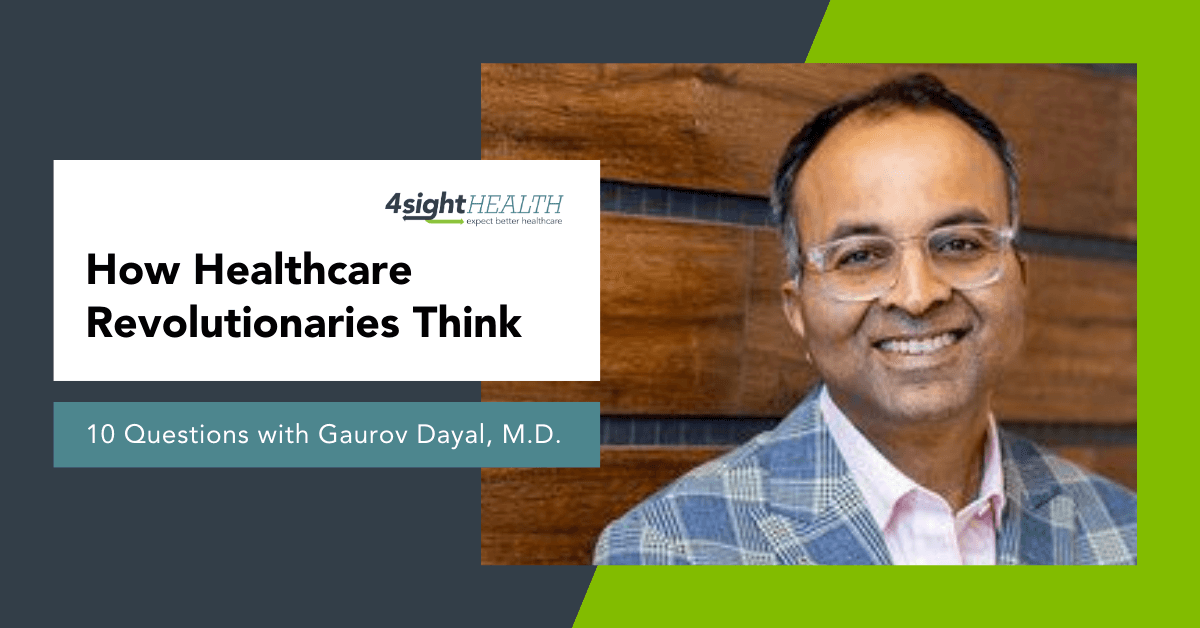February 2, 2021

How Healthcare Revolutionaries Think: 10 Questions with Gaurov Dayal, M.D.
Welcome to the first installment of 4sight Health’s new monthly interview series, How Healthcare Revolutionaries Think. The interview series features healthcare leaders who believe that outcomes matter, customers count and value rules.
4sight Health’s inaugural guest is Gaurov Dayal, M.D., the new president and COO of Everside Health, a Denver-based direct primary-care provider built by Paladina Health’s acquisition of Activate Healthcare in 2019 and of Healthstat in 2020. The combined companies operate 350 primary-care clinics in 32 states.
Before joining Everside, Dr. Dayal was president of new markets and chief growth officer for ChenMed, a Miami-based system of primary-care clinics for seniors where he led ChenMed’s national expansion. Dr. Dayal is also the former senior vice president of health system solutions and strategy at Lumeris; president of healthcare delivery, financing and integration at SSM Health Care- where he oversaw Dean Health plan and all Value Based care initiatives; and chief medical officer of Adventist HealthCare and president of Adventist Medical Group.
We asked Dr. Dayal about the future of healthcare generally and of value-based care in a post-pandemic healthcare world specifically.
1. You’ve had an interesting and varied career path after graduating medical school in 1996. What’s one of the big healthcare delivery lessons you learned along the way that you still believe in?
Dr. Dayal: It was clear to me early on that the only way to provide enhanced care for patients is through better alignment of the financial incentives between providers and payers. Payment models that incentivize great outcomes at the lowest cost only work if both the payer and provider are aligned — and the patient wins. When the incentives aren’t aligned, you get what you have today, which primarily is a fee-for-service, transactional payment system where the patient’s convenience and outcomes are secondary considerations.
2. What about business model lessons? What did you learn along the way that you’ll bring to your new position at Everside Health?
Dr. Dayal: In terms of business model, I learned the value of being hyper-focused. To use a fast food analogy, Legacy health systems today are a lot like McDonald’s. They want to be everything to everybody. In the end, they’re not special to anyone. Healthcare organizations need to be more like Chick-fil-A, Chipotle and Shake Shack that have carved out niche areas of fast food and deliver very specific services with high quality, service and hyper efficiency. McDonald’s is struggling to be everything to everyone and as result is not good at anything. Successful healthcare organizations in the future will share the same business model characteristics — hyper-focused on a specific service for a particular population to provide superior customer service.
3. Many would say that McDonald’s is a very successful fast-food chain. What’s the lesson there?
Dr. Dayal: McDonald’s WAS a very successful fast food chain. They were also a virtual monopoly in the fast food space. The lesson is that you don’t have to improve your menu or your customer service if you’re the only restaurant in town or the only one open at the airport. It’s about market share. The more you have, the less motivated you are to innovate. Incumbent healthcare organizations with dominant market positions may do well financially like McDonald’s did in the past, but are they really serving their customers to the extent they should be?
4. What’s the disconnect between market share and innovation?
Dr. Dayal: When providers and payers get bigger though mergers and acquisitions and other forms of consolidation, they have bigger operating budgets and more mouths to feed. It’s a short step from there to leveraging your market power to negotiate better financial terms in reimbursement contracts. You’re less interested in assuming clinical and financial risk. It’s why we’re still dependent on fee-for-service.
5. The COVID-19 outbreak exposed that FFS dependence in a big way with the dramatic drop in patient volume and revenue. Will it be enough to kick the FFS habit?
Dr. Dayal: It’s more like one step forward and two steps back in terms of transitioning to value-based care. COVID-19 revealed the downside of FFS and the upside of VBC. But, the decline in revenue has been so steep and so deep, the only way to get out of the hole is FFS. More patients, more revenue, as fast as possible. As promising as VBC is to both providers and payers, patients will have to wait until everyone gets back to even again. And that may be well into 2022, maybe 2023. Unfortunately I think COVID-19 will slow down, the already slow, transition to value.
6. What other flaws in our healthcare system did COVID-19 expose that inhibit innovation?
Dr. Dayal: COVID-19 also exposed the over-regulation of healthcare. Most regulations have nothing to do with what’s best for patients. For example, state licensing laws create artificial monopolies that protect providers and payers that do business in that state. Telemedicine is a great example. The laws prevent an innovative or lower-priced alternative developed in one state from being adopted in another state. They also protect incumbent practitioners by restricting what other qualified practitioners can do for patients. Pharmacists can and do give vaccinations safely, and nurse practitioners can safely prescribe drugs for simple illnesses, but regulations limit that. This guild mentality holds innovation back and hurts patients. With FFS, incumbents won’t risk doing anything innovative, and by virtue of their market share and state laws, they won’t let anybody else do it either.
7. If necessity is the mother of invention, and there’s no necessity, what’s a mother to do? Is innovation dead until the industry fully recovers from COVID?
Dr. Dayal: Not at all. I argue that disruptive innovation will accelerate. With so many incumbent healthcare organizations falling back on their traditional business models to recover, it’s opened the door wide for others. COVID-19 has shown us what’s possible. Patients are receiving effective care in the home through remote monitoring and telemedicine, providing increased convenience. It’s illustrated to policy makers that suspending or eliminating unnecessary regulatory barriers can speed the adoption of new care delivery models like virtual care. It’s revealed to payers that virtual care can produce the same outcomes at less cost. Incumbents, meanwhile, are adding more cost to the system.
8. Give me three reasons why these new market entrants and start-ups will be successful?
Dr. Dayal: Again, it’s because they are laser-focused on one thing. It’s what they do. It’s all they do. They do it better than anyone else. And they do it at less cost than anyone else. We have seen this in Medicare Advantage providers, and are now seeing it in telehealth. Second, they’re attracting record amounts of venture capital which enables them to have the capital needed to rapidly scale, take risk and worry less about short term profits. Third, there is access to more creative staff. They’re not recruiting someone from a competing health system to do the same old thing. They’re hiring people from outside healthcare with totally different skill sets who view the delivery of medical care in an entirely new way. The diversity in thought feeds these companies with fresh ideas.
9. What about focus on the customer?
Dr. Dayal: An entrepreneurial healthcare company like the one I just described sees its customers very differently than an incumbent company with built-in market share. To the entrepreneurial company, every customer counts because you’re starting from scratch. You must attract them, and you must keep them. For an incumbent company in a dominant market position, if they lose you as a patient, they’ll just get another without really trying. There’s less focused on each customer as an irreplaceable asset.
10. Where do you see value-based care a year from now and five years from now given the market dynamics you’ve described? Will we be having the same conversation or a different one?
Dr. Dayal: Nothing is going to change in a year, so we would be having the same conversation. Five years from now will be a different story because of virtual care. Apps, remote monitoring, telemedicine, home care, hybrid care. I’m 100 percent sure that we’ll be having a different conversation about value-based care because those innovations will expand access and decrease the cost of care delivery. We’ll be able to deliver primary care earlier because almost all primary-care services can be delivered virtually.
4sight Health thanks Dr. Dayal for his time, insights, forecasts and his candor about where the industry is now and what changes need to happen to make the healthcare system work better for its customers — the patients.





